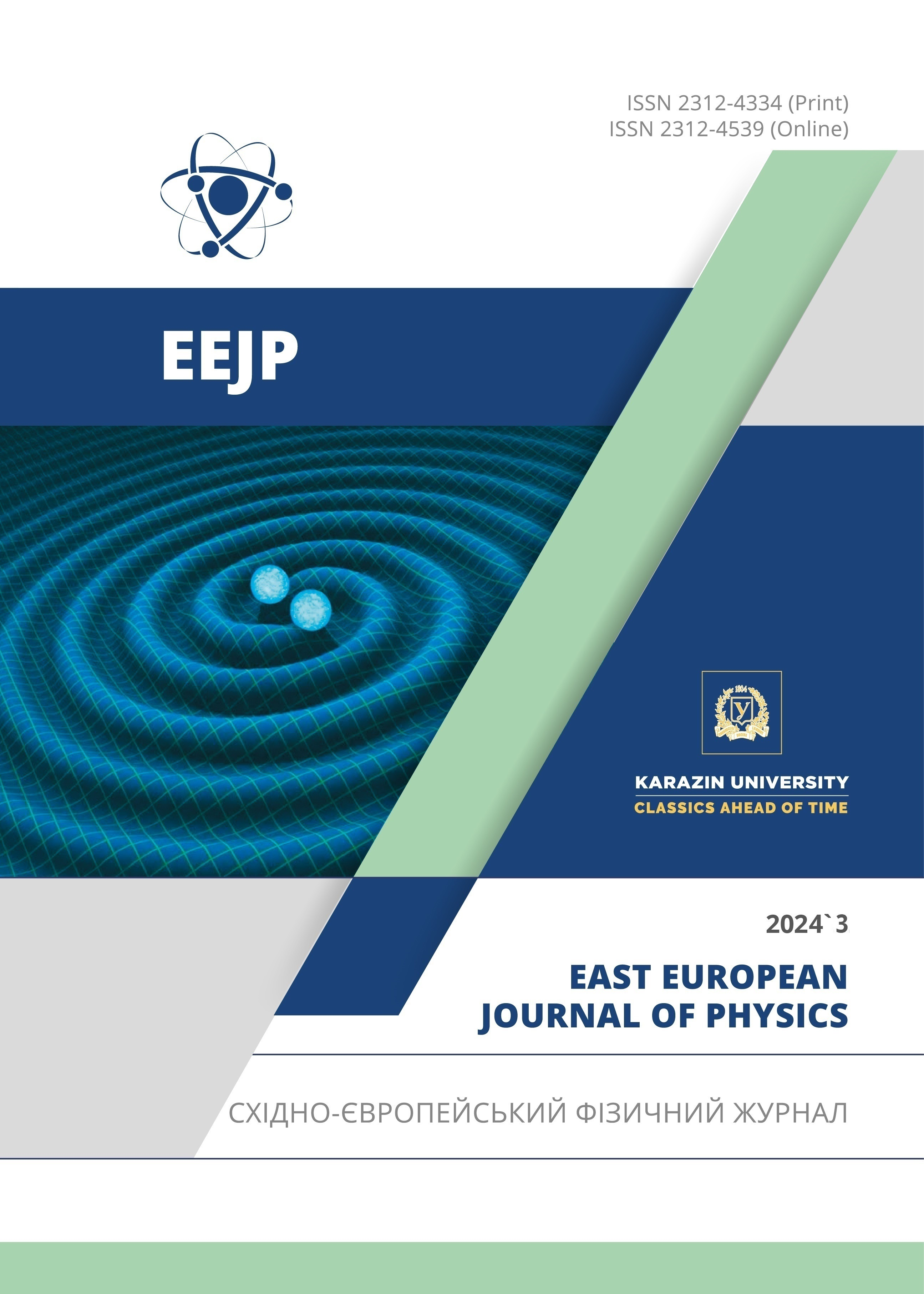Constraining Logarithmic f(R, T) Model Using Dark Energy Density Parameter Ω_Λ and Hubble parameter H_0
Abstract
Of many extended theories of gravity, f(R, T) gravity has gained reasonable interest in recent times as it provides interesting results in cosmology. Logarithmic corrections in modified theories of gravity have been studied extensively. In this work, we considered logarithmic correction to the trace term T and took the functional form as f(R, T) = R+16πGαlnT where α is a free parameter. The free parameter is constrained using dark energy density parameter ΩΛ and Hubble parameter H0. The lower bound is found to be α ≥ −9.85×10−29. The cosmological implications are also studied.
Downloads
References
A.G. Riess, A.V. Filippenko, P. Challis, A. Clocchiatti, A. Diercks, P.M. Garnavich, R.L. Gilliland, et al., ”Observational evidence from supernovae for an accelerating universe and a cosmological constant,” The Astronomical Journal, 116, 1009 (1998). https://doi.org/10.1086/300499
S. Perlmutter, G. Aldering, G. Goldhaber, R. Knop, P. Nugent, P.G. Castro, S. Deustua, et al., ”Measurements of Ω and Λ from 42 high-redshift supernovae,” The Astrophysical Journal, 517, 565 (1999). https://doi.org/10.1086/307221
E.J. Copeland, M. Sami, and S. Tsujikawa, ”Dynamics of dark energy,” International Journal of Modern Physics D, 15, 1753 (2006). https://doi.org/10.1142/S021827180600942X
N. Aghanim, Y. Akrami, M. Ashdown, J. Aumont, C. Baccigalupi, M. Ballardini, A. Banday, et al., ”Planck 2018 results-vi. cosmological parameters,” Astronomy and Astrophysics 641, A6 (2020). https://doi.org/10.1051/0004-6361/201833910
S. Weinberg, ”The cosmological constant problem,” Reviews of modern physics, 61, 1 (1989). https://doi.org/10.1103/RevModPhys.61.1
A.A. Starobinsky, ”Dynamics of phase transition in the new inflationary universe scenario and generation of perturbations,” Physics Letters B, 117, 175-178 (1982). https://doi.org/10.1016/0370-2693(82)90541-X
S. Nojiri, and S.D. Odintsov, ”Modified gauss–bonnet theory as gravitational alternative for dark energy,” Physics Letters B, 631, 1-6 (2005). https://doi.org/10.1016/j.physletb.2005.10.010
S. Nojiri, and S.D. Odintsov, ”Modified gravity and its reconstruction from the universe expansion history,” Journal of Physics: Conference Series, 66, 012005 (2007). https://doi.org/10.1088/1742-6596/66/1/012005
M. Sharif, and A. Ikram, ”Energy conditions in f(G,T) gravity,” The European Physical Journal C, 76, 640 (2016). https://doi.org/10.1140/epjc/s10052-016-4502-1
T. Harko, F.S. Lobo, S. Nojiri, and S.D. Odintsov, ”f(R,T) gravity,” Physical Review D, 84, 024020 (2011). https://doi.org/10.1103/PhysRevD.84.024020
J.B. Jim´enez, L. Heisenberg, and T. Koivisto, ”Coincident general relativity,” Physical Review D, 98, 044048 (2018). https://doi.org/10.1103/PhysRevD.98.044048
Y. Xu, G. Li, T. Harko, and S.-D. Liang, ”f (q,t) gravity,” The European Physical Journal C, 79, 708 (2019). https://doi.org/10.1140/epjc/s10052-019-7207-4
S. Nojiri, S. Odintsov, and V. Oikonomou, ”Modified gravity theories on a nutshell: inflation, bounce and late-time evolution,” Physics Reports, 692, 1-104 (2017). https://doi.org/10.1016/j.physrep.2017.06.001
S. Bhattacharjee, J. Santos, P. Moraes, and P. Sahoo, ”Inflation in f(R,T) gravity,” The European Physical Journal Plus, 135, 576 (2020). https://doi.org/10.1140/epjp/s13360-020-00583-6
M. Gamonal, ”Slow-roll inflation in f(R,T) gravity and a modified Starobinsky-like inflationary model,” Physics of the Dark Universe, 31, 100768 (2021). https://doi.org/10.1016/j.dark.2020.100768
B. Deb, and A. Deshamukhya, ”Inflation in f(R,T) gravity with double-well potential,” International Journal of Modern Physics A, 37, 2250127 (2022). https://doi.org/10.1142/S0217751X22501275
C.-Y. Chen, Y. Reyimuaji, and X. Zhang, ”Slow-roll inflation in f(R,T) gravity with a RT mixing term,” Physics of the Dark Universe, 38, 101130 (2022). https://doi.org/10.1016/j.dark.2022.101130
S. Bhattacharjee, and P. Sahoo, ”Constraining f(R,T) gravity from the dark energy density parameter ΩΛ,” Gravitation and Cosmology, 26, 281-284 (2020). https://doi.org/10.1134/S0202289320030032
M. Houndjo, and O.F. Piattella, ”Reconstructing f(R,T) gravity from holographic dark energy,” International Journal of Modern Physics D, 21, 1250024 (2012). https://doi.org/10.1142/S0218271812500241
A. Pasqua, S. Chattopadhyay, and I. Khomenko, ”A reconstruction of modified holographic ricci dark energy in f(R,T) gravity, Canadian Journal of Physics, 91, 632 (2013). https://doi.org/10.1139/cjp-2013-0016
J. Singh, and N. Sharma, ”Bianchi type-ii dark energy model in f(R,T) gravity, International Journal of Theoretical Physics, 53, 1424-1433 (2014). https://doi.org/10.1007/s10773-013-1939-y
D. Reddy, R.S. Kumar, and T.P. Kumar, ”Bianchi type-III dark energy model in f(R,T) gravity,” International Journal of Theoretical Physics, 52, 239-245 (2013). https://doi.org/10.1007/s10773-012-1325-1
R. Zaregonbadi, M. Farhoudi, and N. Riazi, ”Dark matter from f(R,T) gravity, Physical Review D, 94, 084052 (2016). https://doi.org/10.1103/PhysRevD.94.084052
N. Godani, and G.C. Samanta, ”Wormhole modeling in f(R,T)gravity with minimally-coupled massless scalar field,” International Journal of Modern Physics A, 35, 2050186 (2020). https://doi.org/10.1142/S0217751X20501869
A.K.M. Shweta, and U.K. Sharma, ”Traversable wormhole modelling with exponential and hyperbolic shape functions in I framework,” International Journal of Modern Physics A, 35(25), 2050149 (2020). https://doi.org/10.1142/S0217751X20501493
Copyright (c) 2024 Biswajit Deb, Atri Deshamukhya

This work is licensed under a Creative Commons Attribution 4.0 International License.
Authors who publish with this journal agree to the following terms:
- Authors retain copyright and grant the journal right of first publication with the work simultaneously licensed under a Creative Commons Attribution License that allows others to share the work with an acknowledgment of the work's authorship and initial publication in this journal.
- Authors are able to enter into separate, additional contractual arrangements for the non-exclusive distribution of the journal's published version of the work (e.g., post it to an institutional repository or publish it in a book), with an acknowledgment of its initial publication in this journal.
- Authors are permitted and encouraged to post their work online (e.g., in institutional repositories or on their website) prior to and during the submission process, as it can lead to productive exchanges, as well as earlier and greater citation of published work (See The Effect of Open Access).








